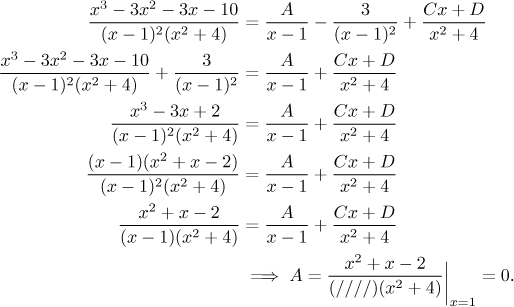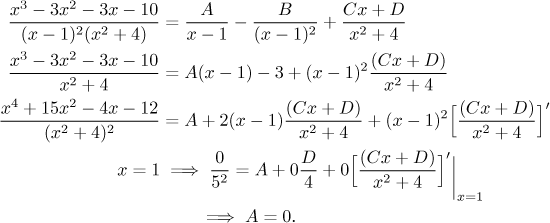
Here we will show some other methods that can be used to determine unknown constants in a partial fraction decomposition. We will illustrate them on the decomposition

We already determined one constant using the cover-up method, because it is the simplest possible and there is no point in trying to find a replacement for it. The other constants would be normally determined using the multiplying method, which is exactly the moment where we would appreciate some alternatives.
Linear factors 1.
We start with the problem of finding A, in general of finding the
other constants related to a linear factor that appears in a higher power.
The first interesting method is based on common sense. Using the cover-up
method we determine

So we did find A, but simplifying the ratio on the left was probably more work then the whole multiplying method. Still, there might be problems where this trick is convenient.
Linear factors 2.
Here we will try to generalize the cover-up method. Recall that it was based
on the following procedure. We take a decomposition that focuses on some
linear factor

We then substituted in

Personally, I'd rather do the multiplying method. If we differentiate more times, we get also to other constants. This is interesting from a theoretical point of view, since we obtain a general formula for all constants at fractions with linear expressions. (Advanced readers may find an interesting connection with residua and in general with Laurent expansion of complex functions.)

Quadratic factors 1.
Here one can use an interesting version of the plug-in trick. Constants at
linear factors (at the highest powers) can be obtained by substituing roots
of linear factors, constants at quadratic partial fractions of highest power
can be reached by substituting complex roots.
In our example the complex factor has a root
![]()
By comparing the real and imaginary parts we obtain equations
If some quadratic factor is present in a higher power, this trick will again only help with the partial fraction corresponding to the highest power.
Quadratic factors 2.
If you do not mind working with complex numbers, there is still
another trick. If we allow complex roots, then every proper rational function
can be decomposed into partial fractions associated with linear factors
only, that is, with the most conveinent ones. We then also get complex
coefficients. In our example we would get
![]()
We can now use the cover-up trick with appropriate roots to find b, c and d, the last two go

The last constant
![]()
We therefore obtained a decomposition whose advantage is that all the factors ale linear, which means that we can easily integrate it:
![]()
There are two disadvantages to this approach. First, the complex calculations were quite difficult, but for some that may not be such a big problem. What really is a problem is that the answer contains complex numbers, whereas the question only deals with real numbers. Thus the answer should be somehow algebraically simplified so that we get rid of all complex numbers, and this can be very difficult (and usually is). Perhaps this is the reason why people tend to avoid this complex decomposition approach when dealing with real integrals.